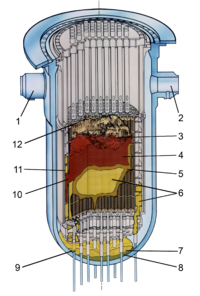
Photo from wikipedia
Abstract Zirconia-containing soda-lime silicate glasses with compositions of xZrO2-(75-x)SiO2-15Na2O-10CaO, where x = 0, 1, 3, 5 and 7, were studied using classical molecular dynamics (MD) simulations to understand the effect of ZrO2/SiO2… Click to show full abstract
Abstract Zirconia-containing soda-lime silicate glasses with compositions of xZrO2-(75-x)SiO2-15Na2O-10CaO, where x = 0, 1, 3, 5 and 7, were studied using classical molecular dynamics (MD) simulations to understand the effect of ZrO2/SiO2 substitution on the short-, medium-range glass structures, and properties such as ionic diffusion and mechanical behaviors of these glasses. Local environments of Zr4+ and other cations such as bond distance and cation‑oxygen coordination number as a function of composition were systematically analyzed from pair distribution function and bond angle distribution calculations. It was found that Zr O bond distance is around 2.12 A and zirconium coordination number is around 6, forming slightly distorted [ZrO6] octahedron, with both showing little changes with composition. Silicon maintains perfectly four-fold coordinated with a Si O bond distance of 1.61 A throughout the glass series. Medium-range structural information (e.g., Qn distribution, network connectivity and polyhedral linkages) was also studied as a function of ZrO2 substitution. It was found that [ZrO6] enters the glass-forming network through corner-sharing with [SiO4]. Both Na+ and Ca2+ act as charge compensators of [ZrO6] with slightly higher preference of the latter. Addition of zirconia was found to impact the properties of the glasses: it increases both the low and high temperature diffusion energy barriers of modifier cations and increases the elastic moduli of the glasses. These changes of properties can be explained by the enhanced glass network due to zirconia incorporation.
Journal Title: Journal of Non-crystalline Solids
Year Published: 2018
Link to full text (if available)
Share on Social Media: Sign Up to like & get
recommendations!